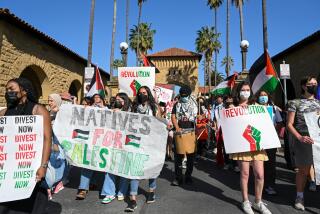Navy Says Stanford Overbilled U.S. but Rejects $200-Million Estimate
- Share via
Stanford University appears to have overbilled the federal government for research overhead costs, but allegations that the school owes taxpayers as much as $200 million are based on faulty calculations, the inspector general of the Office of Naval Research said in a report released Thursday.
Because of the questions raised by the Stanford case, the inspector general recommended audits and legal reviews at the school and all other universities that receive federal research funds and bill the government overhead costs involving buildings, libraries and administration.
Not surprisingly, different sides of the controversy put forward different readings of the much-awaited report. At stake are millions of dollars as well as the reputations of Stanford and Paul Biddle, who has been the Navy research overseer at Stanford since 1988 and is the most vocal critic of the school’s research costs.
Stanford President Donald Kennedy, in a prepared statement, said he is “very pleased” with the results of the Navy investigation. “I hope the findings of the inspector general will put to rest these unfortunate allegations,” Kennedy said, adding that he welcomed audits of Stanford’s indirect research costs from 1980-89.
But, clearly, the controversy is not over.
The six-month investigation found no evidence of collusion between Stanford officials and government employees who supervise research grants there. But according to a Navy spokesman, the inspector general’s conclusion will not affect a separate Navy probe into possible criminal charges involving what Biddle alleged were sweetheart deals.
U.S. Rep. John D. Dingell, the Michigan Democrat whose House Energy and Commerce Committee is investigating spending at Stanford and some other prestigious schools, said the report reinforced his intention to hold hearings on the matter next month.
“The Navy does say the charges are not likely to be $200 million but I find that a curious conclusion since the Navy makes that statement without ever having performed any audit of any account,” Dingell said from Washington through a spokesman. The Navy research office and the Department of Health and Human Services are supposed to set overhead rates for federally funded research.
Dingell had taken up the issue after he received reports that the university had billed the government for flowers, wine, antiques and a yacht. Stanford has withdrawn $684,000 worth of those bills, but insists they were either mistakenly submitted or were legitimate but not worth the bad publicity.
Biddle could not be reached for comment Thursday.
The new report said that Biddle’s “methodologies, assumptions and computations were primarily judgmental and speculative in nature, rather than factual” when he alleged in September that Stanford’s overbilling might be a third of the $600 million in overhead costs it received in the 1980s. Most of Biddle’s data, the document continued, “was not verified or verifiable by supporting documentation and not reconciled or reconcilable to accounting records.”
The inspector general, M. E. Hite, added, however, that “there appears to be some validity” to Biddle’s concerns that the government overpaid Stanford. “However, we have been unable to substantiate or reliably estimate the exact amount,” the investigator stated.
Moreover, as a result of Biddle’s whistle-blowing, Navy officials said all research contracts between universities and the government will be more closely scrutinized. In a statement accompanying the report Thursday, Rear Adm. William C. Miller, Chief of Naval Research, said, “The national interest demands that the government pay its share of costs involved in supporting university research, but also that scarce research dollars are spent wisely and accounted for with the diligence that the taxpayers deserve.”
The inspector general also looked into Biddle’s charge that senior officers in his organization traditionally gave special treatment to Stanford. The report noted that a former Office of Naval Research employee, who helped oversee federal grants to Stanford, later went to work for the university and maintained a close friendship with another Navy employee who continued to monitor government research at Stanford. The report concluded that “no apparent partiality” was found, despite a possible perception of one.
Stanford’s bills to the government for indirect costs grew from 58% of research funds in 1980 to 74% last year, topped only by Harvard Medical School (77%) and Columbia University (74.1%). Dingell’s congressional staff reportedly is investigating all three schools and others as well. The government wants to give Stanford 70% this year.
Larry Horton, Stanford’s associate vice president for public affairs, contended that the university had requested audits in the past but not received them. “We are suffering from the lack of those audits. . . ,” he said. “In the long run, what is most important to us is public confidence in the research funding process. We want strengthened accountability.” He spoke by telephone from the Washington office of Hill & Knowlton, the prominent public relations firm hired to help Stanford through the bad publicity.
Stanford has withdrawn $684,000 worth of charges to the government for such items as flowers, wine, antiques and a yacht, but insists those bills were either mistaken or were legitimate but not worth the embarrassment defending them would bring.
More to Read
Sign up for Essential California
The most important California stories and recommendations in your inbox every morning.
You may occasionally receive promotional content from the Los Angeles Times.














